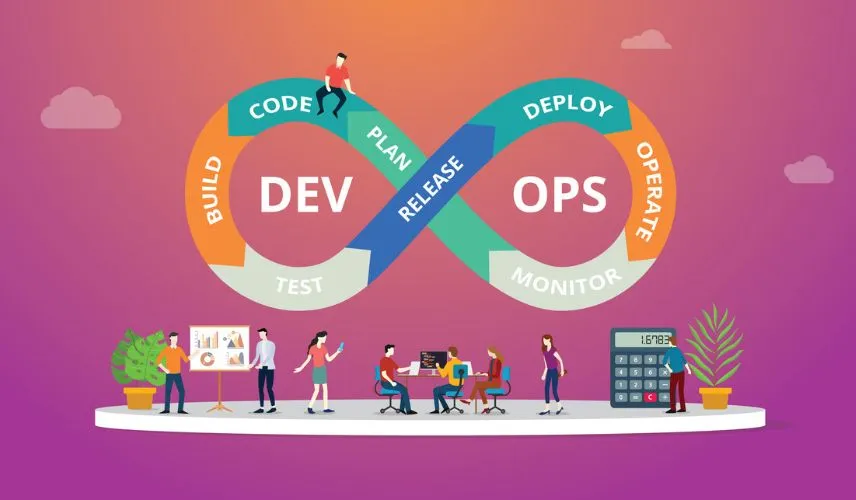
DevOps strategy: How does DevOps help boost your productivity?
DevOps refers to practices that bridge the gap between software creation and server management. Its goal is to shorten the SDLC, allowing for continuous delivery of high-quality software. DevOps and Agile software development work well together, with many DevOps practices originating in Agile.
DevOps is a collection of practices encouraging agile thinking and rapid software delivery. Continuous integration, continuous delivery and deployment, collaboration, automation, and monitoring are some of the first concepts that spring to mind when discussing DevOps.
DevOps is centered on continuous performance and rapid code delivery. Thus it's crucial to move quickly and avoid making any significant mistakes.
In addition, automated deployments made possible by dev partners are the future's saviors. Waiting for a key to be distributed to compose manually might be difficult for the developer. The organization may save time and decrease the likelihood of error by automating this process. Keep reading about the ways how DevOps boost productivity.
Ways By Which DevOps Boosts Productivity
Ongoing Integration
Continuous integration is an effective method for automating development processes. Code updates and builds may be integrated automatically using CI. A DevOps implementation technique is based on rapid and automated system deployment tenets. Developers may benefit from continuous integration since it facilitates frequent code merges and builds.
A significant advantage of using CI is saving substantial time throughout the development cycle. Two additional benefits are reducing the time spent on correcting regression problems and emphasizing high code quality. In general, having a solid CI pipeline lets you get insight into the codebase and what you're building for the end users.
Constant Shipping
CD, or continuous delivery, is a reliable software distribution technique that speeds up teams' development of high-quality software. With the help of a Continuous Delivery pipeline, you can be sure that the software will be delivered on time and with little interference from your team. Software Continuous Delivery (CD) is a robust DevOps release approach for accelerating software development, testing, and distribution.
CD's primary benefit is code ready to be deployed and used in production. CD utilizes a pipeline that allows for continuous delivery. The software can be released on time with little intervention from humans.
On the other hand, continuous delivery relies heavily on the practice of continuous integration. Developers may save their code in a repository during constant integration and have it ready for production during continuous delivery.
Microservice Architecture
There has been a recent uptick in using "microservices" in the software industry. Complex applications are represented as discrete, deployable services. The term "microservice" refers to an updated SOA (SOA) form. Microservices have the benefit of being technology neutral and communicating with one another in a variety of ways.
The ability to break down large software projects into smaller, more manageable chunks is made possible by combining microservices with DevOps. Deploying Microservices in the cloud also eliminates the need to write code particular to a specific platform. So, it helps you save money while offering you more options for deployment and development.
Insightful Response Time
DevOps approaches allow for rapid iterations of business, development, testing, and IT operations. Using DevOps, groups may work more quickly and efficiently. Rapid growth and processes are essential to creating a high-quality result, and feedback loops are crucial. Feedback loops that are short and frequent lead to better outcomes in both product and process development. Let's use an example to talk about this.
A continuous integration/delivery pipeline is an essential short feedback loop. The developers may monitor the bugs and repair them when they are found. In the long run, this facilitates a quicker delivery of the goods.
Scheduling and Kubernetes for Container Management
The container management system is essential to the success of a DevOps approach since most modern apps run inside containers rather than on a traditional virtualized infrastructure. Containers aid DevOps in accelerating the process of creating and releasing new software. Engineers in the DevOps community use docker to make these containers, and Kubernetes allows them to orchestrate them.
File and library-containing software may be packaged into containers that include everything else the program needs to execute. Kubernetes, on the other hand, reaches out to control all of the infrastructure's containers. To scale up or down your infrastructure, you may use Kubernetes' support for multi-tenancy on cloud-based SaaS platforms.
Conclusion
DevOps aims to improve communication and cooperation between software development teams and IT operations teams to facilitate the quick deployment of applications and reduce downtime, delays, and other problems that are detrimental to the user experience.
This article has covered the benefits of DevOps and how it may boost productivity. Maintaining ongoing DevOps operations requires making strategic choices about development and technology, and the appropriate conclusion indicators may assist. So, no more waiting! It is best to opt for cloud computing and get ahead to the best benefits for businesses.





